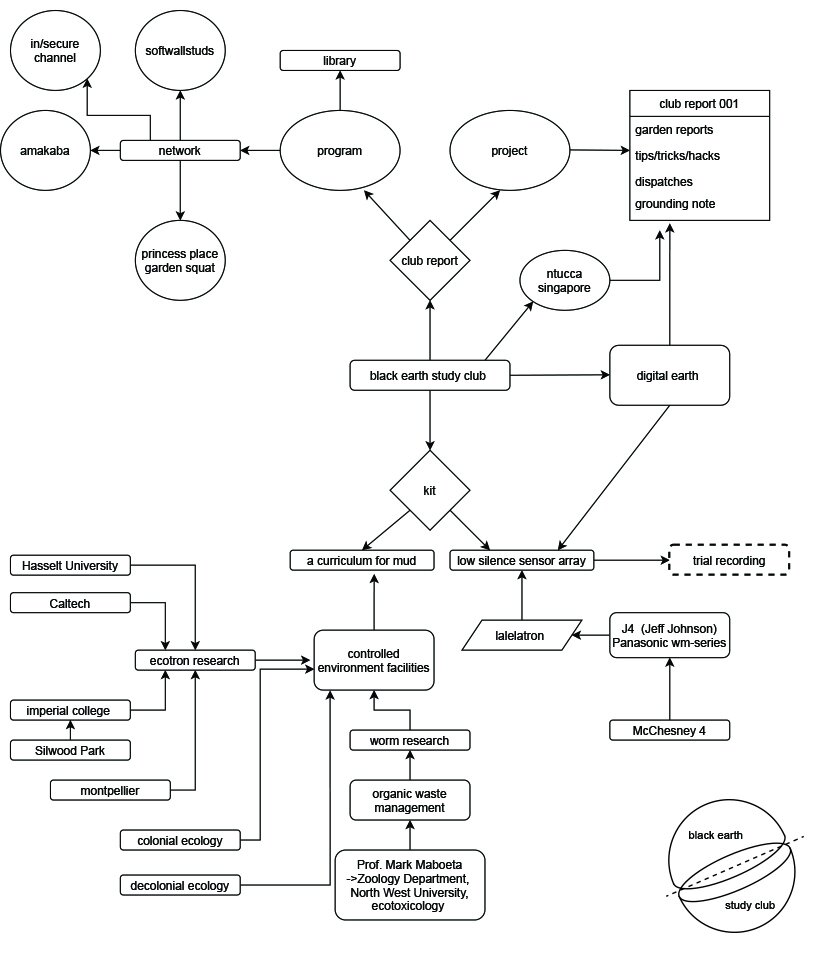Susan Schuppli visits Nolan Oswald Dennis
Introduction by Susan Schuppli
The creative practice of Nolan Oswald Dennis assembles a wide array of ideas and materials within the framework of his "black earth study club", in particular soil to explore the material legacies of colonial imaginaries (botanical gardens, zoos, aquariums) and their recursive logics of ordering, classification, and overall management of life. Through a series of situated experiments in infrasonic recording (using a purpose-built microphone sensor array) made in an experimental garden in Johannesburg, Nolan brings the vibrational qualities of soil into presence as a felt-effect: a series of audio playbacks and listening sessions.
While the specific relevance of these recorded vibrations, which we experience as pitch-shifted audio tracks that have been modified in post-production, elude explicit comprehension as to what was recorded, the experience of staying with the trouble of ‘noise’ is productive, in that, it refuses to privilege ‘signal’ as the locus of all meaning. Instead we turn our attention to the sonic substratum that organises our listening experience, delving into the rich densities of the earth—the biotic life of soil and what comes to be registered as “black silence."
Over the course of many online studio sessions together, Nolan’s work prompted wide-ranging discussions that brought aesthetics, technology, ecology, and politics together in novel configurations. Throughout we also explored the different spatial scales and temporalities that are operating across his research projects. His is an expansive and future-oriented practice that is continually forging new connections between past events and contemporary conditions to create imaginative new assemblies.
For our final studio session we have reflected on some of the more conceptual questions that inform his work, especially the recording strategies and processes of translation that he is trying to develop to enable a relational shift in perspective capable of combining the anthropocentric with the more-than-human. How to ‘attune’ ourselves to the ‘other’ without reducing or flattening the incommensurabilities that organise different material realities and expression remains a provocative challenge for his work.
Low Silence—a black earth study club_common project
[summary]
This presentation contains field recordings of soil taken at subsonic frequencies -(20hz)
[Details]
This is a trial infrasonic recording made in the studio garden box at 9 Alexander Street, Ferreirasdorp, Johannesburg 07/06/2020. This recording was made on a lalelatron j4, a prototype infrasonic sensor based on the J4 open source microphone designed by Jeff Johnson.
[prompt]
There are 3 scales of concern:
1) Our general task is to re-establish relations with test earth. To regenerate relations which are historically denied. Also to remake existing relations otherwise - to reengineer what we have toward what we don’t.
2) Our strategic task is to become planet as collective praxis. To build ourselves as sensitive apparatuses (which combine sensing with attentiveness) in order to meet the earth otherwise. Tools that might enable us to find ourselves already in the earth.
3) Our specific task is to access an acoustic ecology of possibility by listening to the earth in its black silence. To unearth (which is also re-earthing) the possibility of other knowledge in the infrasonic spectrum. This project embraces the low silences which are overdetermined by sensing technologies used for mining safety, prospecting, seismic monitoring (ie. disaster monitoring) and military observation and battlefield support. However, the military industrial overdetermination of infrasonic vibration does not exhaust the low silences. There is still space for a different kind of sensing, our task is to propose and propagate an impossibility already present in the signal~noise. Our task is to learn to listen.
[description]
This recording was made in a garden box at a shared studio complex in Johannesburg. The dimensions of the box are approximately 900wx600lx450h millimetres. 50% of the boxes volume is polystyrene fill, the other 50% is soil made of found/donated soil, coco coir and worm castings. These two layers are separated by an agricultural textile. In the garden grows an array of indigenous succulents.
Specifications:
Station : studio garden box
Sensor : lalelatron j4 50A, 0.2-50 Hz, 0.4 V/Pal
Speedup : ×200 (transposed up about 8 octaves)
Loop duration (audio): 07:11 (stereo)
Spectrogram type : raw
Gain correction : 0dB
Audition post-processing : highpass -2 30 highpass -2 30 compand 0.001,0.016:-80,-50,-40,-10,0,-3
Recorded on : Mon June 07
[additional content]
>image files<
an organisational diagram of the Black Earth Study Club
BESC_org_diagram.jpg
studio garden box_spectrogram_screenshot.png

